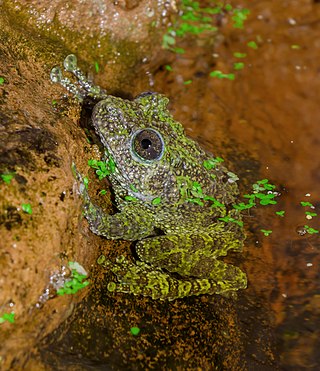
Theloderma, the bug-eyed frogs, mossy frogs or warty frogs, is a genus of frogs in the family Rhacophoridae, subfamily Rhacophorinae. They are found from northeastern India and southern China, through Southeast Asia, to the Greater Sunda Islands; the highest species richness is in Indochina. Some species, especially T. corticale, are sometimes kept in captivity.

Theloderma asperum is a frog in the family Rhacophoridae. It is also known as the pied warty frog, hill garden bug-eyed frog, or somewhat informally, bird poop frog. The frog can be found in the northeastern India, Burma, China, Thailand, Cambodia, and Vietnam as well as Sumatra in Indonesia. However, because of confusion with Theloderma albopunctatum and Theloderma baibungense, it is known with certainty from its type locality in Peninsular Malaysia.
Orixalus ananjevae, the Ananjeva Asian treefrog, is a species of frog in the family Rhacophoridae.
Theloderma petilus, the slender warted tree frog or slender bug-eyed frog, is a frog in the family Rhacophoridae. It is occurs in Vietnam, where it has been observed in the Muong Nhe Nature Reserve. It is also native to Laos and Thailand. Scientists think it may live in China.

Taruga longinasus is a species of frog in the family Rhacophoridae. It is endemic to Sri Lanka. It has been observed between 150 and 1300 m above sea level.

Theloderma corticale is a species of frog in the family Rhacophoridae. It is found in northern Vietnam, south–central Laos, and southern China.
Theloderma stellatum, the Taylor's bug-eyed frog, purple-spotted warted frog, spotty warted tree frog, stellar bug-eyed frog, or Chantaburi bug-eyed tree frog is a species of frog in the family Rhacophoridae. It is found in Thailand, Cambodia, Laos, and Vietnam. Its natural habitats are subtropical or tropical moist lowland forests, subtropical or tropical periodically flooded lowland and montane forests between 0 and 1500 meters above sea level. This species deposits eggs in rain water collected in small tree holes; the tadpoles feed on the organic matter aggregated in a tannin-rich rain water. Notches aiming resin collection increase carrying capacity of the frogs providing additional breeding sites.
Theloderma licin, also known as the smooth frog and the white-backed bug-eyed frog, is a species of frog in the family Rhacophoridae found in peninsular Malaysia, southern Thailand, and Indonesia's Sumatra island. It inhabits lowland to montane forests. It can be found in water filled tree holes, bamboo cuts, or man-made objects like metal pipes.
Theloderma palliatum is a species of frog in the family Rhacophoridae. It is endemic to Vietnam and so far only known from the Bidoup Núi Bà and Chư Yang Sin National Parks. This species, together with Theloderma nebulosum, was first found by Australian and Vietnamese scientists in Tay Nguyen in 2011.

Theloderma albopunctatum, the dotted bubble-nest frog, warty tree frog, rough-skinned small tree frog, cobalt-gray warted frog, rough-skinned whistling tree frog, rough-skinned small tree frog, rough paddle-leg frog, white-banded small tree frog, white-patterned small tree frog, white-spotted bug-eyed frog, or pied warted tree frog, is a species of frog in the family Rhacophoridae. It is endemic to China. Scientists believe it may also live in Vietnam, Laos, and Cambodia. There are similar frogs in India, Myanmar, and Thailand, but scientists suspect these are a complex of related species.
Theloderma vietnamense, the South Vietnamese bug-eyed frog or South Vietnamese bug eye frog, is a frog in the family Rhacophoridae. It is endemic to Vietnam, Cambodia, and Laos. It has been observed no higher than 1400 meters above sea level.
Theloderma truongsonense, the Truong Son bug-eyed frog, is a species of frog in the family Rhacophoridae. It is endemic to Vietnam and Laos. It has been observed between 300 and 1300 meters above sea level.
Theloderma ryabovi, or Ryabov's bug-eyed frog, is a species of frog in the family Rhacophoridae. It is endemic to Vietnam. Scientists know it from the type locality.
Theloderma nagalandense, the Nagaland tree frog, is a species of frog in the family Rhacophoridae. It is endemic to India. Scientists know it from the two type localities. Both are in Nagaland State, one 1196 meters above sea level and one 1421 meters above sea level.
Theloderma lateriticum, the brick-red bug-eyed frog, is a frog in the family Rhacophoridae. It is native to Vietnam and China and has been observed 1130 meters above sea level.
Theloderma pyaukkya, the Burmese camouflaged tree frog, Burmese warty tree frog or Burmese bug-eyed frog, is a species of frog in the family Rhacophoridae. It is native to China and western Myanmar.
Theloderma annae, Anna's bug-eyed frog or Anna's mossy frog, is a species of frog in the family Rhacophoridae. It is endemic to Vietnam. It has been observed in the Ngoc Son–Ngo Luong Nature Reserve and Cuc Phuong National Park.
Theloderma lacustrinum, the lake bug-eyed frog, is a frog in the family Rhacophoridae. It is endemic to Laos. Scientists know it exclusively from the type locality: Ban Naxang Village near the Nam Lik Reservoir.
Liuixalus calcarius, the limestone small tree frog, is a species of frog in the family Rhacophoridae. It is endemic to Vietnam, where it was found in Hai Phong Province. It lives in tropical primary forest habitats rich in karst rock.

Philautus nephophilus is a species of frog in the family Rhacophoridae. It is endemic to Malaysia, where it has been observed in Kinabalu National Park, between 1400 and 1800 meters above sea level.





